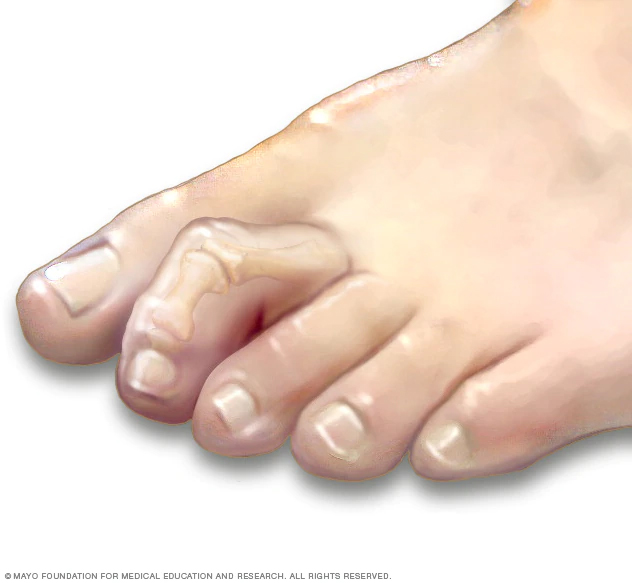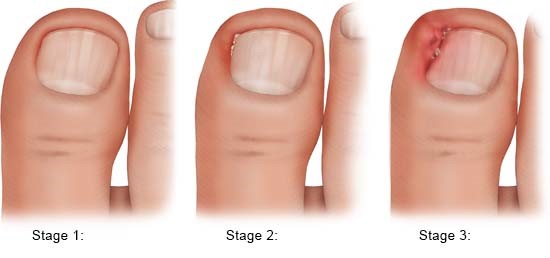Minor Surgery
Dr. Kearl is board certified through the College of Podiatric Surgeons of British Columbia. He has many years’ of experience in a variety of surgical procedures. All surgery is done using local anesthetic and completed at VPI offices.
HAMMERTOES
A condition where a toe is bent or has contracted. It usually occurs in the lesser toes. Hammertoes themselves usually are not painful, however the friction of them rubbing against the inside of shoes can create a build-up of thick, hard skin (a corn), which can be very uncomfortable.

Causes:
Hammertoes are usually the result of foot misalignment. Although the condition may be inherited, usually over-pronation causes the tendons on the bottom of the foot to pull on a funny angle, causing a buckling or bending of the toes. Over time, a toe can become fixed in a bent position. Corns, which form as a result of rubbing inside of shoes, are actually a type of protective layer of thick skin over the toe joints. Tight or ill-fitting (running) shoes, which rub against the toe, will tend to make this condition painful.
Treatment:
It is always best to try to catch this, or any condition, in the earlier stages, before the toe becomes fixed. Orthotics can often serve to correct the biomechanical faults, which cause the hammertoe.
There are also over-the-counter devices called hammertoe crest pads, which serve to try to move your toe back into a normal position, assuming it is not rigid or already fixed. Corns can be removed with a pumice stone, or by a podiatrist quickly and painlessly in the office. Toe joints that are susceptible to recurrent corns can be protected with moleskin or other pads.
If the toe is in a fixed bent position, the choices are either to put up with the discomfort, get deeper or more accommodating shoes or undergo a relatively minor surgical procedure to correct the contracted joint.
Prevention:
Make sure your shoes are wide and deep enough to prevent rubbing, irritation, and the formation of a corn. Motion-control shoes and/or orthotics can serve to reduce any over-pronation.
Sports medicine is an important part of Valley Podiatry. Dr. Kearl sees many high performance athletes, and creates orthotics to support the demands of high impact running.
When evaluating for foot pain, Dr. Kearl performs a biomechanical evaluation, and then prescribes corrections. The foot is cast into plaster molds, and then sent to our laboratory for fabrication, according to specific recommendations from the Podiatrist. Many insurance companies require these steps to be fulfilled in order to qualify for coverage.
INGROWN TOENAILS
Ingrown toenails are a common condition in which the corner or side of a toenail grows into the soft flesh. The result is pain, redness, swelling, and sometimes an infection. Ingrown toenails usually affect your big toe, but can also affect the lesser toes. If you have diabetes or another condition that causes poor blood flow to your feet, you’re at greater risk of complications of ingrown toenails.

Ingrown toenail symptoms include:
- Pain and tenderness in your toe along one or both sides of the nail
- Redness around your toenail
- Swelling and redness around the nail
- Infection of the tissue around your toenail
Common ingrown toenail causes include:
- Wearing shoes that crowd your toenails
- Cutting your toenails too short or not straight across flat thin nails
- Injuring your toenail
- Having unusually curved toenails (genetic)
Soaking your toe in salt water (Epsom salts) and applying an antibiotic cream can help reduce the inflammation. If it persists, Dr Kearl is able to cut the nail in a slant back position, or wedge resection.
If the ingrown nail returns, A nail surgery can be done in the office to permanently remove the ingrown nail. This is done by freezing the toe, removing a narrow strip of the nail, and killing the nail root in the corner. Healing time is minimal.
If you have a persistent painful nail, call Valley Podiatry Inc. to book an appointment.
SOFT TISSUE LESIONS
Painful lesions, such as ganglionic cysts, myxoid cysts, and fibroma’s can be removed using local anesthetic and a small incision.

